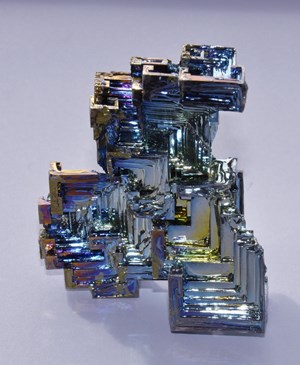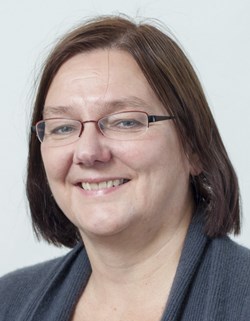
Semi-metallic bismuth crystal, used in thermoelectric compounds and special bearing alloys. © ESA
Metals are central to the progress of civilization. From the early furnaces of the Copper Age to the present-day laboratories developing sophisticated alloys and compounds, metallurgy has shaped most aspects of man's daily life for the past 10,000 years.
As the world enters a new age, characterized by an ever-growing need across the industrial landscape for new, high-performance materials, a renewed effort is needed to develop high-value, high-efficiency metal products.
Europe has decided to meet this grand challenge—as grand as the energy challenge it is closely connected to—by establishing a one-billion-euro research program "that can design, develop and deploy the next set of revolutionary alloys and composites for key industrial applications," as recommended in 2012 by the European Science Foundation.
The program, called Metallurgy Europe, will cover seven years and include contributions from 170 companies and laboratories from 20 countries. According to its promoters, it has the potential of creating over 100,000 new jobs in the materials, manufacturing and engineering sectors.
"This new program allows us to enter the high-tech metals age. The top management of industry have come together for the first time on this important topic, and there is a confident feeling that Metallurgy Europe will deliver many unique, exciting and profitable technologies," explains David Jarvis, head of strategic and emerging technologies at the European Space Agency and chairman of Metallurgy Europe.
Fusion is among the fields of research and industry that stand to benefit most from such an initiative. We asked Elizabeth Surrey, Technology Programme Leader at the Culham Center for Fusion Energy, CCFE (one of the partners in Metallurgy Europe) to explain what is at stake for the fusion community.
Why is metallurgy so important for fusion's future?
Fusion research is entering a more technology and industry focused phase and new, advanced technologies are required to successfully deliver economical fusion power. Key to this drive will be the development of new materials that can operate within the unprecedentedly demanding environmental conditions anticipated in future fusion reactors, for example high radiation levels, high temperatures and very high heat fluxes. Advanced manufacturing and characterization will be critical in developing these new materials as well as in understanding the effects of the fusion environment on current and future alloys; thus, the success and economics of fusion power critically requires active engagement with metallurgy.

Elizabeth Surrey, Technology Programme Leader at the Culham Center for Fusion Energy (CCFE): ''The success and economics of fusion power critically requires active engagement with metallurgy.''
CCFE has recently established a Materials Research Laboratory. What is the aim of this lab? How will it relate to the Metallurgy Europe program?
The new Materials Research Laboratory is part of a larger multi-site endeavour in the UK known as the National Nuclear User Facilities. These facilities are key research centres aimed at empowering our scientists to study and understand the effects of irradiation damage on materials, and metals in particular, using the most state-of-the-art equipment and techniques. The Materials Research Laboratory is already assisting in our understanding of irradiation damage and will help understand and develop new irradiation-resistant materials.
The Materials Research Laboratory is one of the most advanced facilities for microscopy and micro-mechanical testing of materials across Europe. The facility will interlink with the wider Metallurgy Europe program through collaborative research utilizing state-of-the-art equipment and the growing knowledge base at CCFE. We anticipate that these programs will focus on a range of cutting edge research into nuclear materials, including the development of novel characterization techniques, helping to keep fusion science at the head of materials research.
What does CCFE expect from the Metallurgy Europe program?
The Metallurgy Europe program will be one of the key gateways for CCFE, and the fusion community, to be at the forefront of materials research. Through active engagement with the Metallurgy Europe program, CCFE can assist in highlighting the exciting materials and manufacturing challenges faced by fusion and engage a wider participation into these investigations to find novel and synergizing approaches to the critical issues. CCFE is already engaged in pan-European projects, developing novel alloys and utilizing advanced additive layer manufacturing techniques, and we aim to develop these areas and also expand into new areas. Ultimately CCFE's engagement will be key to developing joint projects aimed at accelerating the metallurgical research required in fusion, especially advanced steels and tungsten and its alloys.



